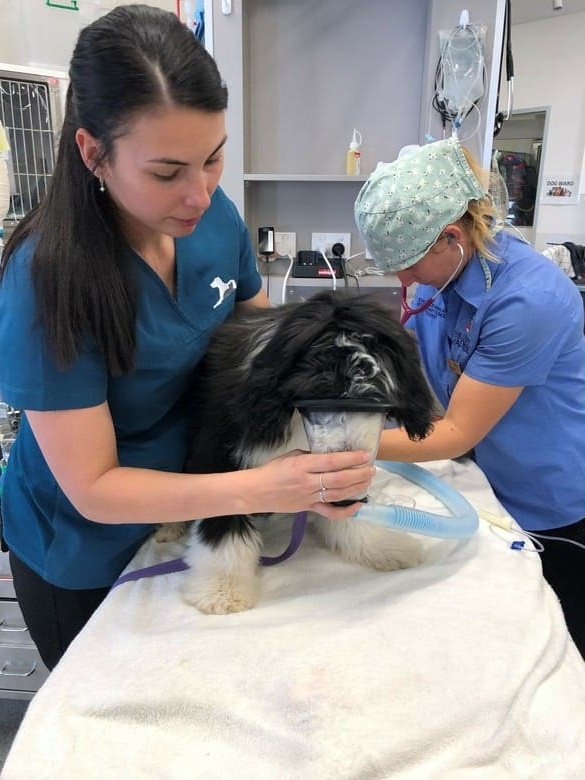Well, we’ve already had our first snake-bite of the season. Young ‘Piper’, a Bearded Collie pup, was brought in by her owner, Tammy McClelland. Tammy had found her out in the garden collapsed and feeling very unwell. Although Piper improved fairly quickly, Tammy (an experienced veterinary nurse) knew that this could be caused by snakebite and so she rushed her straight in to see us.
By the time Piper arrived, she was looking a bit off-colour again and Dr Jenny immediately ran some blood tests. Snake venom from Eastern Brown snakes (the vast majority of snakes in our area are ‘Brownies’) causes an increase in clotting times in dogs and we can use this as a pretty accurate diagnostic test. As it turns out, Piper’s results were off the charts and so Dr Jenny started immediate treatment.
Treatment involves oxygen, intravenous fluids, anti-inflammatories and pain relief but, most importantly, anti-venine. The severity of signs in dogs depends on how much venom is in the system. If cornered, ‘Brownies’ will bite repeatedly and it would seem that this was the case with Piper. After the first vial of anti-venine, Piper responded quite well but then went downhill again. Dr Jenny added a second vial and, after this, Piper started to settle down.
I’m happy to report that, after 24 hours of treatment and monitoring, Piper was able to go home. Blood tests showed that there was no significant damage to her kidneys or other organs. She was one of the lucky ones. If not for the rapid action on Tammy’s part and the treatment from Dr Jenny and the team, there is a strong chance that Piper wouldn’t have survived this level of envenomation.
Every year we’re confronted with a number of cases of snakebite in both dogs and cats. If left untreated, snakebite is most often a fatal disease and, as such, it’s really important that you’re aware of the dangers.
Given that snakes are warm-blooded creatures, Spring and early Summer is the time we start to see them each year. Of course it’s also breeding season for the snakes and so there’s plenty of activity out there. Snakebite is an absolute emergency in dogs, as you can see from Pipers’ tale. Even where owners are not sure if their pet has actually been bitten, we always recommend coming in for assessment RIGHT NOW!
With all this in mind, I’d like to give you a few tips regarding snakebite – what does it look like, when does it happen, what do you need to do?
- Snakes are warm-blooded and so active in hot/warm weather
As reptiles, snakes are cold-blooded creatures and rely on environmental conditions to warm themselves. As such, they lie dormant throughout most of winter before coming back into action at the first signs of a warm, sunny day.
- Brown snakes are extremely aggressive, if cornered, and highly venomous
Snakes will avoid us, if possible, and only become aggressive if cornered. When that happens, though, Brown snakes become very aggressive and will strike multiple times. They’re one of the two most venomous snakes in the world so being bitten by one is not a great idea! Unfortunately, Gawler is pretty much the epicentre of the Brown Snake world so we see lots of them! Although not as common in our area, Red-bellied Blacks are also highly venomous. They’re seen more often near a stream or wetland which is why we don’t see so many of them (no water = no streams!).
- Both dogs and cats will chase or hunt snakes – they think it’s fun (at the time)!
Both dogs and cats are predators and cats, in particular, are very efficient hunters. When confronted with a snake, they’re very likely to go on the attack, and this is where problems occur. Hunting is an inbuilt characteristic in many breeds of dog and in most cats. For them, it’s fun and they don’t recognise the dangers in most cases.
- Your pets don’t learn from the experience of being bitten so ‘once bitten, twice shy’ doesn’t apply!
The bite from a snake is not usually particularly painful at the time and the effects of the venom take some time to show. Unfortunately, your pet doesn’t learn that playing with a snake is a bad thing to do. As such, even a badly affected snakebite victim won’t learn from the process and is just as likely to be interested the next time he or she sees a snake.
- Snake venom is a ‘neuro-toxin’ and so causes muscle paralysis
The venom is a potent neuro-toxin and can quickly result in respiratory and cardiac failure.
- Weakness, collapse, paralysis and excess vocalization (in cats) are the main signs.
Pupils also tend to dilate in cats. Some dogs will have an initial collapse then appear to recover for a few minutes – don’t be fooled, this is usually the precursor to much more severe onset of signs.
- Snakebite is a flat-out emergency!!
Although cats can take several hours to show clinical signs, dogs can die within half an hour of being bitten. Given the timing I’ve just described above, it’s probably pretty clear that snakebite is a flat out emergency. Even if you’re not sure whether there has actually been a bite, you need to get in to see us as soon as possible!! By all means, phone us on the way but don’t hang around on your way in here.
- We can treat snakebite but you have to be quick, particularly with dogs
We have very good anti-venom to combat the effects of snake-bite. The key is timing and applying this before the toxin takes hold is ideal. With appropriate treatment, recovery is rapid in dogs. In cats, things can move a lot more slowly (not always) and we often need several days of hospital treatment. Not all snakebite victims survive, even with treatment, but our chances are much better with rapid action.
- A simple blood test tells us if your dog has been bitten
It can take a while for the clinical effects of snake-bite to develop. Prior to this, however, snake venom usually causes changes in the clotting mechanism in dogs. We can test this to detect whether your dog has any venom in the system. The test only takes a few minutes to run and, if elevated, we’ll always recommend immediate treatment. Unfortunately, this test doesn’t help us with cats as they react differently.
- Avoidance is better than cure
Make sure you keep all long grass mown down in any areas your pets have easy access. Also don’t leave piles of wood or rubbish as this is frequently where snakes hang out. If you’ve already seen a snake in your yard, then it’s a great idea to call a snake-catcher (look up the web for your closest service). There are several ‘snake posts’ on the market and some people swear by them – they are designed to deter snakes by giving off a constant vibration in the ground. Not sure how well they work but worth looking into.
Now that the warm weather has arrived, you need to be really aware and on the lookout for signs of danger for your pets. If you think there’s any chance your pet has been bitten, don’t waste any time – bring them in to see us pronto. Better to be safe than sorry – don’t let your pet be a victim of snakebite season this year!!






